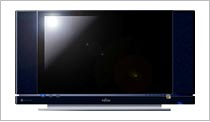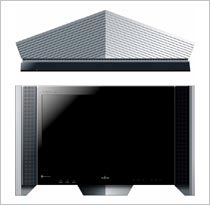Archived content
NOTE: this is an archived page and the content is likely to be out of date.
Home Entertainment PC: Developers' Stories (2)


New wide-screen PC design. Persistence was also flowing in the process of design. We interviewed Mr. Yoshihashi of industrial design, who is a constant challenger to innovation, and Mr. Miyakoshi of engineering, who transforms the new designs into real products.

Kentaro Yoshihashi
Designer, Product Design Department
Design Center

Naoki Miyakoshi
Engineer, Engineering Department I
Desktop Products Division
Personal Systems Business Unit
What started the design image?
|
Yoshihashi: |
I have designed desktop computers and notebook computers in these few years, but the Home Entertainment PC project was slightly different. The LCD is so big! It was my first time handling big-sized wide LCD, I felt that it was a big difference from my past experience. To tell the truth, I wondered how I could deal with such a big LCD initially.  Anyhow, I began rough sketching, and the first thought that came to me was the location the Home Entertainment PC would be placed. The concept of the Home Entertainment PC is a personal computer that can also be used as a television set, so it would naturally be put in a space of daily life such as a living room. Therefore, my starting point of imagination was harmonizing with room design, excellence as an interior décor item of a room, and uniformity with other furniture and home appliances. Instead of starting from the product being a PC, I started from such imagination, and gradually developed into a refined image by studying other furniture and home appliances. |
During your design work, what were the discussion points, and what ideas did you stick to?
|
Miyakoshi: |
My job as an engineer is to create a mechanical drawing from Yoshihashi’s design and turn it into a real product. Before the final design was fixed, we had intensive discussions. Both of us considered various scenarios where our customers could use the Home Entertainment PC. For example, if a customer wants to relax and watch a television program or movie with the Home Entertainment PC after using its PC functions, how should the keyboard and mouse be treated? My guess is that they would not want to see the keyboard during their time of entertainment. Integrating a keyboard space on top of the product would be ugly. After an extensive study of various alternatives, we decided to implement three legs for the Home Entertainment PC so that the keyboard can be stored under the screen. I believe that this product will be smart and cool because of this design.  With regards to the CD/DVD drive position, our initial ideas were to have the drive on the side of Home Entertainment PC, so that the disks are to be inserted vertically. We then put ourselves in the shoes of the customer, and we found out that the position is not ergonomic because the customer had to stand at the side of the Home Entertainment PC and peep into it to handle the disk. As a result, we decided that the CD/DVD drive should be positioned in front. We believe that this front drive design not only made disc handling easier, but also allowed more freedom of usage for customer. For example, customer can pile up CD/DVD disks just next to the product conveniently without them being obstacles to accessing the disk drive. |
|
Yoshihashi: |
What I focused on was not only the shape but also the colour. Plenty of design sketches were drawn before this shape and colour was decided. |
Were there any conflicts between industrial designers and engineers?
|
Miyakoshi: |
I have been engaged in desktop and notebook computer projects with Yoshihashi for about two years now, so I can comprehend his design intention. To be frank, I did not want to implement three legs to the Home Entertainment PC, as there are technical difficulties such as ensuring the strength of the legs. On the other hand, I can intuitively understand how he wants to store the keyboard and mouse under the three legs. Therefore, I decided to fully support his idea and realize the design. On the hindsight, we have successfully transformed a designer idea into a product - this is where the Engineering Department folks demonstrated their expertise. |
|
Yoshihashi: |
A personal computer should clearly exhibit performance and function, and this gives certain restrictions to the industrial designer. On the other hand, as a designer, I wanted to stick to my own ideas of product ‘form’. I think Miyakoshi turned my perfectionist requirements as a designer into the final product by balancing different constraints from both ends. |


